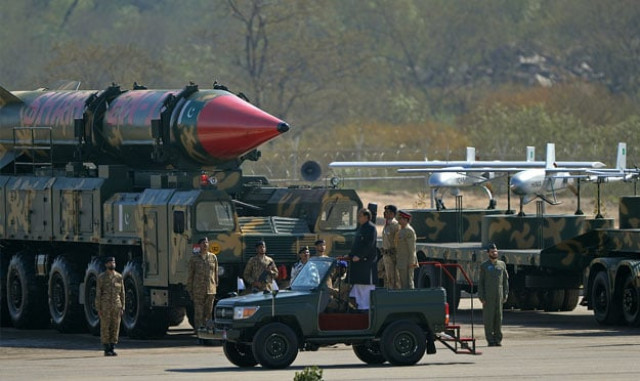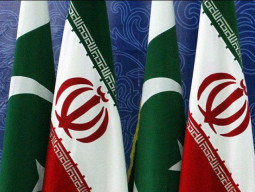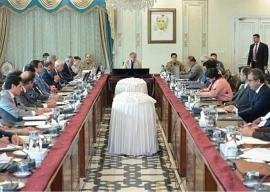
Foreign Secretary Aizaz Ahmad Chaudhry and Under Secretary of State for Arms Control and International Security Rose Gottemoeller co-chaired the meeting. While Islamabad tried to persuade Washington for equal treatment of all non-NPT signatory states for membership to Nuclear Suppliers’ Group, the very reference of Missile Technology Control Regime (MTCR) raised eyebrows in Pakistan’s strategic and diplomatic community, making it appear as if Islamabad had consented to sign as a quid pro quo for NSG membership while India continues to make strides, by hook or by crook, with leading examples including BrahMos and Shaurya hypersonic missiles.
Analysis: Will India’s S-400 missiles checkmate Pakistan?
To a question, the foreign ministry spokesman told the media, “We want all such regimes to have a non-discriminatory criteria-based approach for non-NPT countries.” A source in the foreign ministry said, “There was a passing mention of MTCR during the working group’s meeting.” He didn’t comment as to why such a passing reference should become part of the joint statement.
The MTCR at a glance
The MTCR is neither a treaty nor an executive agreement, but a formal, multilateral understanding about export policy. It’s a non-proliferation tool, which supplements the notion of technological elitism in the realm of delivery systems and un-manned aerial vehicles (UAV).
Embedded in the doctrine of denial, the MTCR aims to limit nuclear proliferation by banning transfer of equipment and technologies that can be used in sophisticated missile systems. Initially, the regime was overwhelmingly focused on ballistic missiles but there has been a gradual shift towards cruise missiles. The regime also imposes severe constraints on national space programmes of developing countries on the pretext that the technologies are interchangeable.
Though the negotiations for the MTCR began in 1983 among the US, UK, West Germany, France, Italy, Japan and Canada, the club was formally created in 1987.
The 34-nation regime restricts member states from exporting a projectile with the maximum range of 300km and 500km payload. MTCR proponents claim Hungary, Poland and Czech Republic helped establish disbarment norms by giving up their missiles. However, there was marginal success in Asia where Taiwan became the only exception. The club has also failed to impress upon Iran, North Korea, Syria, Pakistan and India.
Pakistan says "seriously concerned" by India's missile tests
The 1990s can be marked as an era of chemical and biological weapons’ scare.
The member states hastened increased use of ballistic missiles to the list of items during the Iran-Iraq war for Tehran was actively accessing the technology from the Soviet Union, North Korea and China.
Rules don’t always apply
Nowadays, China is seen as a big problem for allegedly assisting Iran, North Korea and Pakistan in developing missile technologies. However, the MTCR has not been so vocal over joint development of various variants of the hypersonic BrahMos cruise missile by India and Russia. Critics believe the BrahMos experience has incredibly fed into India’s knowhow of the complex system, thus leading to further refinement with extended range and payload. Cruise missile is the centrepiece of India’s pre-emptive cold start doctrine.
France and Britain’s sale of Storm Shadow or Black Shaheen missile to UAE resulted from immense pressure from the industry. The European nations went ahead with the sale of projectiles against US advice and contrary to the MTCR guideline. Another case in point is South Korean development of missiles with ranges varying from 500kms to 1,500kms. The US ally was not impressed enough to rely on external military support in case of a conflict with its northern rival besides mitigating any threats from Japan and China.
In 2004, Pakistan’s launch of its first cruise missile shook India, which had boasted an advantage in the realm. For now, competition for strategic edge in all missile categories and missile defense systems is intense so far.
While Washington presses upon countries like Pakistan to sign the MTCR, it approved the sale of three Global Hawk drones to Japan and four to South Korea. The UAV, banned under category I list of MTCR, can survey 40,000 square kilometres a day. The US-made SM-3 missiles are already part of Japanese arsenal, another inconsistent sale as per MTCR. Even more undercutting is US-Israel joint development of Arrow 3 missile with range of 1,250kms.
Through its selective application thus far, the MTCR is a US-NATO policy tool to coerce non-favourite and hostile states from acquiring self-sufficiency in defense and space programmes. The missile technology will continue to pass from one nation to the other through vibrant and lucrative black market. Countries facing sophisticated sanction have not only been able to achieve nuclear deterrence but also robust delivery systems.
US forces will continue to go after threats on Pakistani soil: Obama
Over the years Pakistan has invested significantly in missile development programmes besides mastering reverse engineering. With India and Iran gaining free access to Russian and Western technology, Pakistan is less likely to engage in any serious negotiations regarding the MTCR. Though, Islamabad has drastically reduced its dependence on US for military hardware, poor economic policies of successive governments leave Pakistan to the mercy of global financial institutions.
Naveed Ahmad is a Pakistani investigative journalist and academic with extensive reporting experience in the Middle East and North Africa. He is based in Doha and Istanbul. He tweets @naveed360




















COMMENTS
Comments are moderated and generally will be posted if they are on-topic and not abusive.
For more information, please see our Comments FAQ